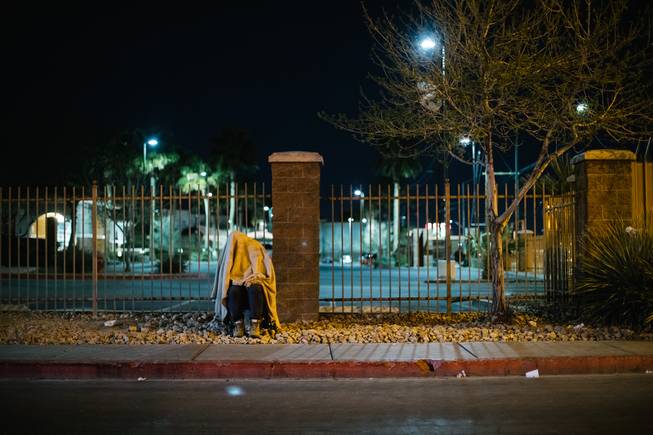
A homeless person sits alone under a blanket near Catholic Charities, at the corner of Foremaster Lane and Las Vegas Boulevard on a 40-degree early morning, Saturday, February 24, 2018. Hundreds of other homeless huddled in a group nearby.
Tuesday, March 13, 2018 | 2 a.m.
Related news
Tena Adamson sleeps with one eye open and a baseball bat within close reach. Same goes for her boyfriend.
That’s just the way it is living on the streets in Las Vegas, where the fear of becoming a crime victim — everything from physical attacks to robberies and rapes — is part of everyday life.
“I sleep with my protection, and I dare someone to walk up on me because I’ll use it,” Adamson said on a recent afternoon, pointing to a wooden baseball bat sitting in an empty dirt lot downtown.
The dangers faced by the homeless in Las Vegas recently made national headlines after a series of shootings — two of them fatal — targeting street people. In less than three months, Metro Police have already investigated the slayings of five homeless people.
“The thing the general public doesn’t understand is the homeless, as a demographic, they’re always being victimized,” police Lt. Joseph Sobrio said.
Adamson doesn’t need any reminders.
She was camping just a couple blocks away when a gunman walked up early Feb. 2 and fatally shot James Edgar Lewis, 64, who was sleeping under the U.S. 95 overpass on 14th Street.
Adamson said the gunshots woke her from her sleep. It was also a wake-up call for the homeless community, which was left shaken by the death of the man everyone called Pops. He was a downtown fixture who was often seen riding his bike and collecting cans.
Joshua Castellon, 26, who was subsequently arrested on a federal weapons count, faces an arrest warrant on two counts of murder and two counts of attempted murder in the shooting of Lewis and three other men apparently targeted at random, authorities said.
Lewis’ slaying frightened Adamson so much that she made her adult daughter and her daughter’s girlfriend, who stays with her on the street, check into a shelter. Another homeless couple, who only gave their names as David and Kellie, also fled the streets, taking shelter in the basement of an apartment building.
Others seek safety in numbers.
“It’s just easiest if you don’t stay to yourself. You get to know the homeless community that way; if something happens, you’re told about it,” Adamson said. “If anybody walked up to me, got to know me and said, ‘You know I stay by myself,’ I’d moved them into my camp so they wouldn’t be by themselves, because I don’t want anybody to get hurt out there.”
Crime statistics involving homeless victims were not readily available. In any case, crimes against the homeless are widely underreported, Metro spokesman Officer Aden OcampoGomez said.
Victims often aren’t comfortable reporting suspects for fear of retribution, and sometimes they can’t effectively make a report because of substance abuse or mental illness issues, he said.
“Sometimes it’s challenging with homeless people, because they can’t really tell us where it happened or when it happened,” said Metro homicide Lt. Dan McGrath.
A team of officers and staff from nonprofit assistance agencies regularly patrol the streets to offer homeless people services. Since January 2017, the team has made 3,700 contacts, helping get 135 people off the streets, officials said.


